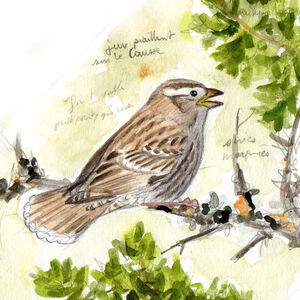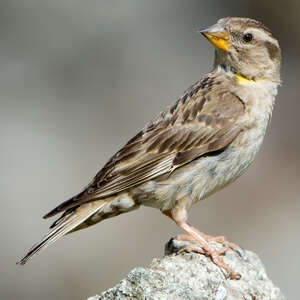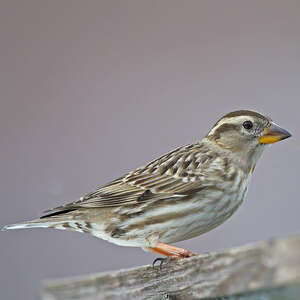Rock Sparrow
Petronia petronia - Moineau soulcie
Identification
Rock Sparrow, Pierre Belon (1517-1564) already called it this way in 1555 in his History of the Nature of Birds, the Latin name of the era was not Petronia petronia but Passer torquatus or collared sparrow, and the common name was forest sparrow. Pierre Belon tells us: We are right to call it the soulcase: for it has its eyes shaded with a white soulcase, on the eyebrows on each side of the head.
Our sparrow measures 15 cm. Its head has a very strong beak whose lower mandible is yellow while the upper one is yellowish-brownish with a darker tip. The crown is white in its center and bordered by two large brown stripes. Two large white eyebrows above the dark eyes are the distinctive mark of the Rock Sparrow. Behind the eyes, a dark post-ocular stripe accentuates the striped aspect of the head. The cheek-strips are light grey and more or less marked depending on the individuals. The whitish throat bears at its base a yellow spot which the bird does not always show.
The mantle and back are striped with beige and dark brown. The scapulars are marked at the end with brown and white. The wing covers are dark brown with a light edging. The remiges have the same colors but when the bird is at rest, only the grey-beige edgings can be seen. The rump is solid. The supracaudals, some of which are very long, are brown. The brown rectrices have a white spot on a blackish background at their tip.
The chest is white with slightly fuzzy light-brown vertical stripes. The flanks are striped more broadly in the same way. The white abdomen is not striped in its center. The under-tail coverts are transversely striped with brown and white. When the Rock Sparrow is perched and does not show its yellow spot, it could be mistaken for an Ortolan Bunting, the two species having a yellow beak.The legs are pink. There is no sexual dimorphism. The young ones are less marked with a dominant brown, the belly is not striated and the yellow spot is absent.
Subspecific information 7 subspecies
- Petronia petronia petronia (Madeira and Canary Is., s Europe to w Turkey)
- Petronia petronia barbara (nw Africa)
- Petronia petronia puteicola (s Turkey to Jordan)
- Petronia petronia exigua (c Turkey to the Caucasus, n Iran and n Iraq)
- Petronia petronia kirhizica (Caspian Sea to Kyrgyzstan)
- Petronia petronia intermedia (Iran and n Afghanistan to nw China)
- Petronia petronia brevirostris (Mongolia, sc Siberia and n and c China)
Foreign names
- Moineau soulcie,
- Gorrión chillón,
- pardal-francês,
- Steinsperling,
- köviveréb,
- Rotsmus,
- Passera lagia,
- stensparv,
- Steinspurv,
- skalník žltohrdlý,
- vrabec skalní,
- Stenspurv,
- kalliovarpunen,
- pardal roquer,
- Steinspör,
- wróbel skalny,
- akmeņzvirbulis,
- skalni vrabec,
- Каменный воробей,
- イワスズメ,
- 石雀,
- stensparv,
- 石雀,
Voice song and call
He cries out with thuiii-thuiii questioning and somewhat grating. One can also hear a repeated, quite sharp, pee-whee, pee-whee. Contact calls in a colony form a babble that has the tone of the cries. The alarm cry is similar to that of other Rock Sparrows, tilililililip, a very rapid succession of resonant notes.
Habitat
No worries for the Rock Sparrow! It is all-terrain, loves rocky environments, Anglo-Saxon call it Rock Sparrow or Rock Dove. It can be found at sea level or at altitudes of more than 4,000m. Close to cultivated areas, orchards or olive plantations in Spain; opportunistic it approaches the cities and can be found in Asia on top of buildings.
Behaviour character trait
Dietfeeding habits
The Rock Sparrow is a granivore at first, which supplements its diet with various berries; during the breeding season, it becomes insectivorous: various beetles, termites, grasshoppers, and dragonflies diversify its daily life. The bird looks for its food on the ground, either alone or in larger or smaller groups. It can hunt flying insects.
Reproduction nesting
The breeding season extends from March to August. The Rock Sparrow usually has two broods during this period.
It can be found both in isolated couples and in colonies. The nests are made of grass, feathers, various animal hairs, and are most often placed in crevices and crevices of rocks, but also in the hollow of a tree, in abandoned dwellings, more rarely in occupied houses. The clutch is 4 to 7 eggs that only the female incubates for 11 to 14 days. She is the one who will feed the little ones, the male having a minor role in the raising of the chicks that will leave the nest after 18 to 19 days.Geographic range
The subspecies Petronia is present in Spain, the Canaries and the southern half of France; ssp Barbara, paler and greyer with brown hints in North Africa and Libya; ssp exigua in Turkey, the Caucasus, Iran and Iraq; ssp puteicola, larger, very pale and much less striped in the Middle East, Israel, Jordan; ssp intermedia in Russia, from the Volga valley to the Aral Sea and Kazakhstan; ssp brevirostris with a very short and strong bill in Asia, northern and central Mongolia, northern China.
The species is resident. It mainly migrates altitude-wise.
Threats - protection
Sources of information
- IOC World Bird List (v15.1), Gill, F and D Donsker (Eds). 2025-12-07.
- Guide encyclopédique des oiseaux du Paléarctique Occidental, BEAMAN Mark
- Handbook of the birds of the world Vol.14, josep del Hoyo
- Le guide ornitho : Le guide le plus complet des oiseaux d'Europe, d'Afrique du Nord et du Moyen-Orient : 900 espèces, Svensson, Mullarney, Zetterstrom
- Les Oiseaux d'Europe, d'Afrique du Nord et du Moyen-Orient, Lars Jonsson
- BirdLife International, BirdLife International
- Wikipédia, Wikipedia, The Free Encyclopedia
- Atlas des oiseaux nicheurs de Midi Pyrénées, Sylvain Frémaux et Jean Ramière
- Identifier les oiseaux d'Europe, Dominic Couzens
- Birds of the World, The Cornell Lab of Ornithology
- xeno-canto, Sharing bird sounds from around the world,
Other sources of interest
 Specification sheet created on
29/07/2023 by Anne et Gabriel Leboff
Specification sheet created on
29/07/2023 by Anne et Gabriel LeboffTranslation by AI Oiseaux.net
© 1996-2025 Oiseaux.net
- Accipitriformes
- Aegotheliformes
- Anseriformes
- Apodiformes
- Apterygiformes
- Bucerotiformes
- Caprimulgiformes
- Cariamiformes
- Casuariiformes
- Charadriiformes
- Ciconiiformes
- Coliiformes
- Columbiformes
- Coraciiformes
- Cuculiformes
- Eurypygiformes
- Falconiformes
- Galliformes
- Gaviiformes
- Gruiformes
- Leptosomiformes
- Mesitornithiformes
- Musophagiformes
- Nyctibiiformes
- Opisthocomiformes
- Otidiformes
- Passeriformes
- Pelecaniformes
- Phaethontiformes
- Phoenicopteriformes
- Piciformes
- Podargiformes
- Podicipediformes
- Procellariiformes
- Psittaciformes
- Pterocliformes
- Rheiformes
- Sphenisciformes
- Steatornithiformes
- Strigiformes
- Struthioniformes
- Suliformes
- Tinamiformes
- Trogoniformes






























